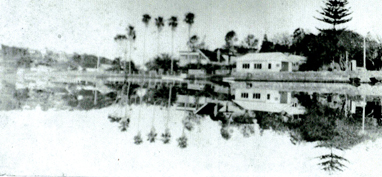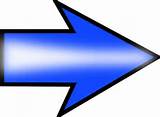
"Billabong" - the end-house at Narrabeen - where
it all began (it did not,
however, have a bay-window - see below)
ONE
WAS where that first-Sunday afternoon tea-party, which
started it all, had taken place.
In chapter 2 Lawrence implies it was at Narrabeen (from
his logistical description...tram trip from Manly, walk
to the lagoon, etc).
Later, in chapter 18, as Somers' boat sails down the Harbour,
Lawrence says specifically it was at Narrabeen (this was
part of the correct ending that Steele decided to omit
from the CUP edition)...
| There
ahead was the open gate of the harbour, the low Heads
with the South Lighthouse, and the Pacific beyond,
breaking white. On the left was Manly, where Harriet
had lost her yellow scarf. And then the tram going
to Narrabeen, where they had first seen Jaz. |
Back in chapter
2 Lawrence had Somers and Harriett walking from the tram
terminus to the lagoon "where the water got in and
couldn't get out" - clearly the end of Ocean Road,
North Narrabeen. After watching some boys skylarking on
the sand, they get up and prepare to go back to catch
the tram back to Sydney. But they see a car outside "the
end-house" and are invited in for afternoon-tea,
which turns out to be the "departure point"
for the rest of the novel.
(The "Jaz" in the above passage is clearly a
reference to Jack Scott - the fictional "Jaz"
turning out to be an amalgam of Hum and Scott.)
However,
for most of our research period (1976-c.2010) I had thought
this end-house, called in the novel "St Columb",
was a place-transposition from "Hinemoa" in
Florence Avenue, Collaroy (and not Narrabeen).
The
evidence for this address, provided initially by Peter
Oatley in 1979, seemed unassailable.
Firstly,
and most importantly, we could place Scott there, c.1922.
His
two stepsons, whom I interviewed in 1976, both remembered
Scott coming to their home, "Hinemoa", in Florence
Avenue, Collaroy, in the period Lawrence was in Sydney
- and indeed the relevant electoral rolls confirmed that
they were living there in 1922.
When
I read the description in Kangaroo of the "St
Columb" end-house and its main room ("with settles
round the windows" - ie, a bay-window) to Peter Oatley,
he confirmed that this was precisely his memory of "Hinemoa",
down to some framed photographs and a medal belonging
to his deceased father Major FDW Oatley hanging on the
walls, just as Lawrence describes in chapter 2:
| There
were many family photographs, and a framed medal and
ribbon and letter praising the first Trewhella. |
(The "settles round the window" description
was also confirmed to me by the man who built "Hinemoa",
Horrie Hayman - see above and my Secret Army Research
notes 3/2/79 entry.)
In addition, "Hinemoa" was both the end-house
in Florence Avenue and was "sideways facing the lagoon"
- the exact, and distinctive description Lawrence gives
to his fictional "end-house" in Kangaroo.
Hum's son, interviewed by John Ruffels, remembered the
Hum family spending the school holidays at Collaroy, and
in particular recalled them taking a rented bungalow in
Seaview Parade, a street that is one block away from "Hinemoa".
(He even recalled the name of the area before it became
known as "The Basin" - it was originally called
"Red Beach", because of the colour of the sand
there.)
Even more indicatively than that, Yeend had said in his
letters to me, several times, that the "house I was
looking for" was in Collaroy Basin. He indicated
that this was where the Friends holidayed (see the Yeend
quote cited above).
When I mentioned Seaview Parade - the Hum vacation venue
- Yeend told me that I would be better off looking in
nearby Beach Road (where I had earlier interviewed Walter
Friend).
And to cap it all, Yeend told me that in the 1920s and
'30s Robert Moreton Friend had spent school holidays in
The Basin with his young family.
However, more recent research by my DH Lawrence Society
fellow-member Robert Whitelaw cast serious doubt on my
"Collaroy scenario", and "Hinemoa"
in particular.
(My principal research "ferret", John Ruffels,
has now retired from pounding the pavement in Randwick,
and is living up the Central Coast, north of Sydney -
though he still helps me via the Internet.)
Robert Whitelaw, who is as diligent and tenacious an investigator
as Ruffels proved to be, focussed his research-attention
on Narrabeen, looking for Lawrence's fictional end-house,
"St Columb" (which in the novel Lawrence located
as being next to Narrabeen Lagoon).
Via a local history of the nearby North Narrabeen Surf
Club, he tracked down someone who had worked for a man
called Charles Schultz, whose wife had owned a large holiday
house called "Billabong" at the end of Ocean
Road, North Narrabeen (see picture of "Billabong"
above).
(Significantly, this end-house was owned by Schultz's
wife - just as in Kangaroo "St Columb"
is owned by Trewhella's wife, Rose.)
Not only was it, ostentatiously, the "end-house"
in the street, but it too was "sideways facing the
lagoon". Moreover, this "end-house, sideways
facing the lagoon" at Narrabeen was a much-more likely
candidate for "St Columb" than "Hinemoa"
at Collaroy.
